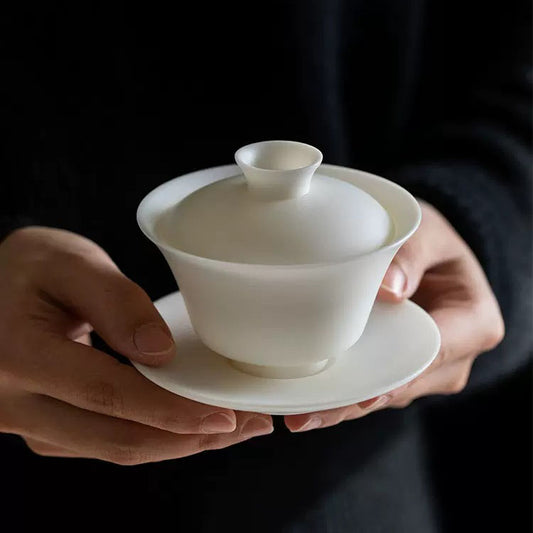Mutton fat jade porcelain tea sets, as a traditional ceramic ware, feature various patterns on their surfaces that come from different historical periods, regions, and cultural backgrounds. In this article, we will explore the pattern styles of Mutton fat jade porcelain tea sets from classical, ethnic, modern, antique, and regional perspectives.
The patterns of Mutton fat jade porcelain tea sets in the classical style usually adopt traditional elements, such as flowers, birds, landscapes, and figures, with warm colors and flowing lines, presenting an ancient and elegant temperament. These patterns are commonly seen in the works of the Ming and Qing dynasties, such as the "Four Seasons Flower and Bird" and "Three Kingdoms Figures" of the Ming dynasty, and the "Eight Immortals Crossing the Sea" of the Qing dynasty. These patterns are not only beautiful but also inherit historical culture, making them an essential representative of Mutton fat jade porcelain tea sets.

The patterns of Mutton fat jade porcelain tea sets in the ethnic style usually adopt traditional patterns and motifs of ethnic minorities, with bright colors and rich ethnic characteristics, presenting a strong ethnic flavor. These patterns are commonly seen in the works of ethnic minorities such as the Tibetan, Mongolian, and Zhuang ethnic groups, such as the "Eight Treasures" and "Four Divine Beasts" of the Tibetan ethnic group, and the "Horse Stepping on Flying Swallows" of the Mongolian ethnic group. These patterns are not only beautiful but also inherit the historical culture of ethnic minorities, reflecting the cultural diversity of Mutton fat jade porcelain tea sets.

The patterns of Mutton fat jade porcelain tea sets in the modern style usually adopt various modern elements, such as abstract patterns and popular elements, with bright colors and diverse forms, presenting a fashionable and avant-garde temperament. These patterns are commonly seen in the works of contemporary ceramic artists, such as the "Black and White Patterns" and "Geometric Patterns" of the modern ceramic artist Wang Guangming. These patterns are not only beautiful but also demonstrate the diversity of contemporary art.

The patterns of Mutton fat jade porcelain tea sets in the regional style usually adopt traditional elements and motifs of the local area, such as lotus flowers in the Jiangnan water towns and fish heads in Guangdong cuisine, with bright colors and local characteristics, presenting a rich local flavor. These patterns are commonly seen in works from various regions, such as the "Ten Eccentrics" and "Eight Eccentrics" of Yangzhou in Jiangsu, and the "Chaozhou Woodcarving Patterns" of Chaozhou in Guangdong. These patterns are not only beautiful but also demonstrate the diversity and characteristics of local culture.

In conclusion, the patterns of Mutton fat jade porcelain tea sets have various styles, each with its unique characteristics and charms. These patterns are not only beautiful but also inherit culture and history, making them an indispensable part of Mutton fat jade porcelain tea sets. With the changing times and cultural exchanges, the pattern styles of Mutton fat jade porcelain tea sets are constantly evolving and innovating, bringing more cultural and artistic enjoyment to people.





